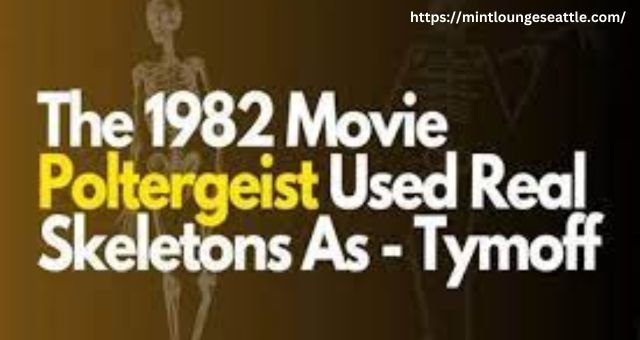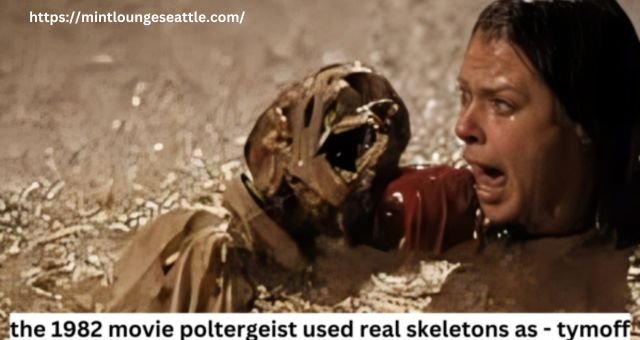The 1982 Movie Poltergeist Used Real Skeletons As – Tymoff: You know it’s wild. We just found out when they made this classic horror flick. Here, they actually used real human skeletons as props.
However, it’s not just the spookiness that gets People talking. It also makes folks think about the ethics behind making movies.
Moreover, it also had those cool side effects. A story that kept you glued to the scene. Also, the eerie atmosphere gave you chills.
But now, knowing they use actual bones. Here, it got everyone debating where we should draw the line. Between making art and keeping things ethical in the movie industry relatively.
In this article, we are going to know about this movie in detail.
The 1982 Movie Poltergeist Used Real Skeletons As – Tymoff – Introduction
Here, after the release of “Poltergeist”, rumors began to circulate. Actual human skeletons were then utilized in certain scenes.
Especially the memorable pool instead of using artificial props.
As a result, this claim stirred a significant discussion and conjecture. With both the film community and among enthusiasts.
The 1982 Movie Poltergeist Used Real Skeletons As – Tymoff – Overview
In the depth of the story of “Poltergeist” amid its depiction of suburban fear. Also, otherworldly disturbances and lies do uncertainly revelation. Especially the real human skeletons that were here used as props.
This choice is prominently showcased in the film’s intense pool scene. Here, JoBeth Williams’ character faces off against the spectral threads of her family.
Starkly juxtaposed the film’s impressive special effects with a somber dose of reality.
Moreover, the production team was aiming for impactful visuals while keeping costs down. Also, opted for authentic human skeletons over artificial replicas.
Further, taking human skeletons over artificial replicas. Arguing that the genuine articles were cost-effective.
However, this pragmatic yet macabre decision wasn’t uncommon in filmmaking at the time.
Moreover, it gathered significant attention due to the film’s prominence and subsequent scrutiny.
The 1982 Movie Poltergeist Used Real Skeletons As – Tymoff – The Unveiled Proofs
Although there has been a lot of talk about “Poltergeist” using genuine skeletons. Here, the proof for this claim is still mainly anecdotal.
JoBeth Williams, who played Diane Freeling in the movie has made a statement. Here, it’s frequently used as one of the main pieces of evidence.
Williams also admitted that she didn’t feel comfortable having a skeleton on the set. Even if she knows they were real.
Further, it’s crucial to remember that Williams’ claim does not offer conclusive evidence. Especially having an actual skeleton was then utilized in the movie.
Here, it’s probable that more than the actual presence of human remains. The creepy mood of the site is also unnerving.
Furthermore, no further cast/crew member has come forward to corroborate this assertion.
The Influence on the Film Industry
It should actually skeletons have been then utilized in “Poltergeist”. Moreover, this might have an impact on the motion picture business.
There are moral questions about how deceased people should be here treated.
Along with how the remains should be also respected. When real humans remain as used as props.
To ensure the ethical treatment of props. The film industry is reportedly subject to tight laws and regulations. As a result, it prioritizes the use of synthesis materials whenever possible.
Here, it’s quite unlikely that a genuine skeleton is also used in the movies. Using them could probably be against the rules.
Moreover, the assertion that real skeletons were further employed in “Poltergeist”.
It has not been substantiated by any concrete evidence or official investigations. It’s crucial to approach claims with skepticism. Also, rely on verified information before forming conclusions.
The 1982 Movie Poltergeist Used Real Skeletons As – Tymoff – Controversy
Outcry from the Public and Industry Response
After the elevation, real skeletons were then used in this movie. Here, The 1982 Movie Poltergeist Used Real Skeletons As – Tymoff. Moreover, it’s significant for the public to demand transparency within the film industry.
Further, advocacy groups focused on ethical filmmaking and historical preservation joined in. Further, calling for transparency regarding the sourcing. Also, the treatment of human remains in film production.
Furthermore, in response, industry organizations and regulatory bodies came together. So, they can address the issue. Also, develop guidelines aimed at preventing similar controversies in the future.
Legal and Ethical Considerations
The debate over “The 1982 Movie Poltergeist Used Real Skeletons As – Tymoff”.
Here, it also spurred questions about the ownership. Also, the rights of human remains are further used in the film. As well as ethical and legal issues reportedly.
The management and disposal of human remains are reportedly governed by regulations.
However, using a genuine skeleton in the movie frequently entails legal ambiguity.
In order to ensure compliance with the legislation. Further, to ensure the dignity of the individual whose remains are here involved.
Furthermore, filmmakers must navigate intricate legal and ethical frameworks.

Conclusion
In the depth of the story of “Poltergeist” amid its depiction of suburban fear. Also, otherworldly disturbances lies do uncertainty revelation. Especially the real human skeletons that were here used as props.
This choice is prominently showcased in the film’s intense pool scene. Here, JoBeth Williams’ character faces off against the spectral threads of her family.
Starkly juxtaposed the film’s impressive special effects with a somber dose of reality.
Moreover, the production team was aiming for impactful visuals while keeping costs down. Also, opted for authentic human skeletons over artificial replicas.
Further, takjng human skeletons over artificial replicas. Arguing that the genuine articles were cost-effective.
However, this pragmatic yet macabre decision wasn’t uncommon in filmmaking at the time.
Moreover, it gathered significant attention due to the film’s prominence and subsequent scrutiny.
Disclaimer
We hope that all the information provided here satisfies your curiosity. However, we can’t guarantee that all the information is 100% accurate.

